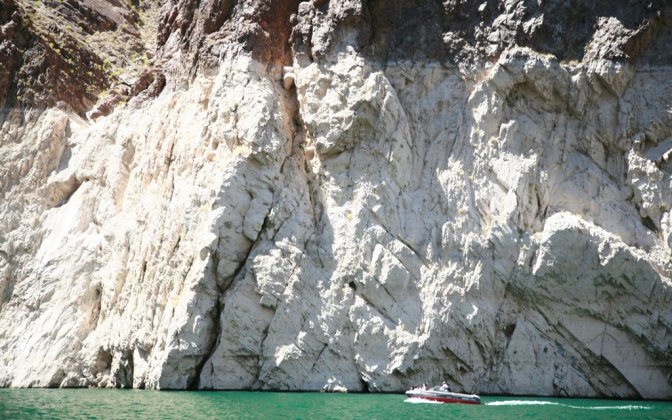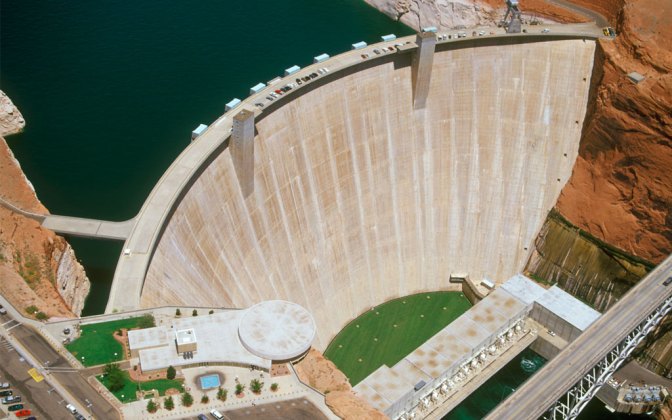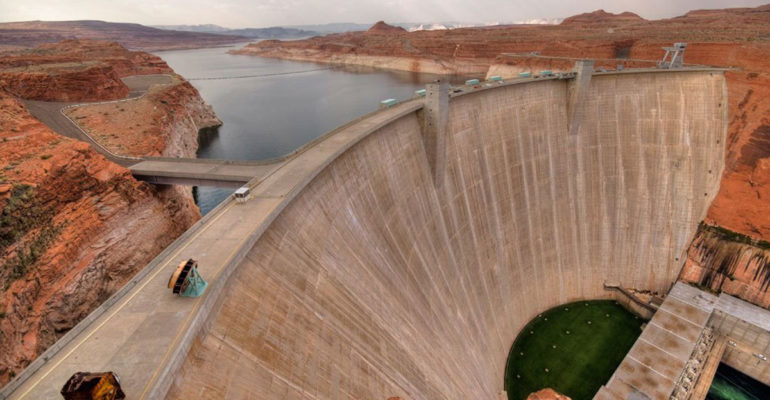The Colorado River is in ecological crisis. Last year Lake Mead fell to its lowest level since the Hoover Dam first obstructed river flow in 1937, and the environmental context for managing the river is changing with a warming planet and the merciless demand for water in the arid southwestern United States. Temporary rules limiting access to water when the level of Lake Mead reaches predetermined emergency levels have been in place since 2007, yet the basic presumptions governing allocation of water are based on standards set more than a half century ago. In an effort to know more about how to best manage the Colorado River, a critical natural resource for Nevada, Assembly Joint Resolution 4 would call on, “the National Resource Council of the National Academy of Sciences to, conduct an independent scientific and economic analysis of the current management practices of the Colorado River, the impact of these practices on water security, flood protection and biodiversity recovery, and alternative management options, including draining Lake Powell and decommissioning and destroying the Glen Canyon Dam.”
Nevada state Senator Tick Segerblom (D-Las Vegas) is one of the bill’s primary sponsors and presented the measure to the Assembly Committee on Natural Resources, Agriculture and Mining on Thursday April 6. Senator Segerblom described the proposed resolution for committee members.
“This bill is a simple issue, a resolution,” Segerblom said. “This Legislature calls for the creation of a study to evaluate the Colorado River basin and how much water is actually out there. There have been studies before, and the current thinking is that there is water out there, but we believe that those studies are false and that there is a shortage, and obviously with global warming it’s not going to get any better. So the reality is, all this does is call for the study. It doesn’t request any funding for the study. It doesn’t do anything other than raise the issue, but I think it is a very serious issue to raise.”
Seven states signed on to the Colorado River Compact in 1922. The Upper Basin states are Colorado, Utah, Wyoming, and New Mexico; and California, Arizona, and Nevada makeup the Lower Basin states, as they are known. The river is some 1,500 miles long and dammed in 15 locations on the main stem. Hundreds of tributaries are dammed as well, and according to estimates, water capture affecting the Colorado can collectively hold 5 times the river’s annual flow.
The Hoover Dam was completed in 1937 and forms Lake Mead. The dam generates an average of 4.2 TWh of electricity a year, and the city of Las Vegas draws 90 percent of its municipal water from the lake. The Southern Nevada Water Authority (SNWA) recently completed a deep underground tunnel that enables the utility to drain Lake Mead dry.
The Glen Canyon Dam is in Arizona and roughly 300 miles up-river from the Hoover Dam. Ladybird Johnson christened the massive cement structure in 1966 under the auspices of the Colorado River Storage Project. The Glen Canyon Dam forms Lake Powell and produces and average 4,217 GWh of electricity a year.

Eric Balken is Executive Director of the Glen Canyon Institute and offered testimony in support of the resolution via the phone during Thursday’s hearing.
“The Colorado River we know today, is not the same Colorado River we knew 50 years ago,” Balken told committee members. “The river is facing an environmental crisis, and many of these adverse effects are direct result of Glen Canyon Dam. This includes the inundation of Glen Canyon itself, a place that was once the biological heart of the entire river system.
“Since its completion in 1963, we’ve lost hundreds of miles of wildlife habitat. We now have 3 endangered fish species, and we’ve seen the steady decline of the Grand Canyon ecosystem from unnatural flows from the dam. So in no uncertain terms, Glen Canyon Dam is one of the most environmentally destruct projects in our nation’s history.”
In some circles destroying Glen Canyon Dam has been a topic of discussion since before it was completed, and in recent years, calls to decommission the dam are growing in number.
“So the idea of draining Lake Powell might seem ludicrous in a world where both reservoirs are full,” said Eric Balken. “But currently, you could completely drain Lake Powell into Lake Mead, and Lake Mead still wouldn’t be full. The previous assumption of water supply that shapes Colorado River management has proven to be wrong.”
 A boat on Lake Mead in 2012 – image – United States Geological Survey
A boat on Lake Mead in 2012 – image – United States Geological Survey
Victor Baker is Regents Professor of Hydrology and Atmospheric Sciences, Geoscience, and Planetary Sciences at the University of Arizona. Dr. Baker specializes in floods, especially rare and extreme floods. Dr. Baker said the limited stream gauge history of the Colorado does not adequately represent the possible range in magnitude of floods that have occurred on the river over its much longer history. Professor Baker explained that dam engineers decide how large and durable a dam to build based on a balance of cost and severe flood probability.
“Engineers try to design for a probabilistic method, and they do this economically to achieve maximum benefit,” Baker said. “The problem with the Colorado River is that the conventional record of floods, which is done with stream gauges, is not adequate to tell about the rarest, largest floods. And the method that has to be used for this is to look to see what nature’s actually presenting to us in regard to ancient floods.”
Dr. Baker described a narrowly averted catastrophe in 1983 when a 1 in 40 year flood event nearly caused the Glen Canyon Dam to fail. According to a presentation on AJR 4, such a “failure would send a 70ft wall of water over Hoover dam for 11 days” and “Obliterate Laughlin and other riverside communities.”
Victor Baker told the committee that larger than expected flood events are not far fetched.
“The floods of the past several thousand years are immensely larger than what’s been experienced, and as you heard, in 1983, the Glen Canyon Dam was almost lost because the reservoir was full at the time, and a flood much smaller than the ones we know nature’s capable of producing, almost destroyed the dam,” said Baker.
 Glen Canyon Dam – image – US Bureau of Reclamation
Glen Canyon Dam – image – US Bureau of Reclamation
Bahoyouma is a Clan Leader from the Hopi tribe village of Mishognonvi and according to his testimony from Carson City last Thursday, he also represents the group Native Waters Rising.
“The damming of the Colorado River submerged our sacred sites and burial grounds,” Bahoyouma said. “We were not consulted prior to the building of Glen Canyon Dam. I am so happy that Assemblywoman Swank and Senator Segerblom are trying to correct the wrongs of the past with this resolution to support a review of the Colorado River by the National Research Council.”
Bahoyouma said the Hopi people support the resolution and its intent, but he came to Carson City to help ensure ancient Hopi sacred sites would be a water priority in the future.
“The Hopi would very much appreciate that the review include the water resources of the Little Colorado River basin that flow into Grand Canyon National Park, because groundwater depletion has seriously impaired the Sipapuni, which is our most sacred shrine.”
Opposition to AJR 4
Leslie James of the Colorado River Energy Distributors Association (CREDA) told lawmakers that the group’s board of directors passed a formal resolution in opposition to AJR4. James described CREDA as an organization of non-profit hydro power purchasers and customers including 52 tribes in a 6 state region, and by phone, James said they were particularly concerned about the notion of draining Lake Powell. She added that CREDA opposes AJR4 primarily because it runs contrary to the authorized purposes of the Colorado River Storage Project.
In her testimony, Leslie James offered a thumbnail of what she described as benefits, “including the funding of environmental programs from power revenues from this dam … the Glen Canyon dam Adaptive Management Program, The Upper Basin Endangered Fish Recovery Program, and the Salinity Control Program, among other things,” James said.
In closing, James encouraged lawmakers to consult the Bureau of Reclamation and the Department of Homeland Security for briefings on dam structure safety and security.
Omar Saucedo testified on behalf of the Southern Nevada Water Authority in opposition to AJR4.
“We are strongly in favor at looking at anything that can be done on the Colorado River to innovate, look creatively for solutions, and we understand groups may want to look to a study,” Saucedo said. “I can tell you that numerous studies have been conducted in the Colorado River Basin. In 2012, the Colorado River states in conjunction with the Bureau of Reclamation, completed a basin-wide study that looked at many scenarios, which demonstrated significant gaps between supply and demand on the Colorado River. Those issues are important to southern Nevada. We have worked very hard to find solutions to those issues and we are supportive of any effort to solve those issues. We are concerned that this study does not really get to what we are trying to accomplish. In 2012, the major municipalities in the lower basin joined with Denver and the Bureau of Reclamation to launch a pilot program that is designed to save a considerable amount of water and store it at Lake Mead. That is a considerably important thing for southern Nevada because the water will prop up lake levels. The elevation level at Lake Mead will determine where and how we can pull water for residents of southern Nevada.”
Mr. Saucedo was certain the proposed study would be redundant. He told lawmakers SNWA was more keenly focused on immediate needs.
“While we understand why this being brought, we are concerned that the bill attempts to duplicate efforts that have already been done at the Bureau of Reclamation and that it will not add to the body of knowledge we already have. We understated the perspective that this study is attempting to focus, however we would like to focus on the immediate needs we have, which is how to deal with the drought and keep communities along the river supplied with water.”
The Colorado River Commission of Nevada represents the state in matters regarding the river, and Jane Harkins spoke from Las Vegas on behalf of the Commission. Harkins told committee members that if not for Lake Powell and Lake Mead, southern Nevada would have had a catastrophic shortage of water following a decade of drought.
“The Bureau of Reclamation and a number of non-federal partners continue to work on additional studies, based on that basin study that was done in 2012, looking at other environmental factors and strategies for allowing us to work through the imbalances that we know that we have on this system because it is an over allocated system.”
Northcutt Ely saw the future
Many gave testimony in support of AJR 4 to include the Toiyabe Chapter of the Sierra Club and the Progressive Leadership Alliance of Nevada. John Weisheit testified in support of the measure by phone. Mr. Weisheit is from Moab, Utah and also known as the “Colorado River Keeper,” one of roughly 300 river keepers around the world that make up the River Keeper Alliance. Weisheit is also an experienced river guide with over 350 river trips through Canyonlands National Park.
During his testimony Weisheit described a meeting of the Colorado River Water Users Association in 1946 in Salt Lake City. At the meeting, Northcutt Ely, former Deputy Secretary of the Interior when the Hoover dam was built, addressed the group and said the original planning documents overestimate the amount of water available in the Colorado River.
“Northcutt Ely said we don’t have that much water, and we’re going to have shortages in the future, and we should readjust the Colorado River Compact and we should revise our planning documents. That was the invitation to the 7 states, and that happened in 1946. That was 71 years ago, and nothing has happened since then,” said Weisheit.
Assemblywoman Heidi Swank (D-Las Vegas) is one of AJR 4’s primary sponsors, and in her closing remarks to committee members she acknowledged the difficulty of 7 states and 2 countries working together to manage rare water resources, but the Assemblywoman also emphasized the dire need for independent, scientific knowledge and long term vision.
“Our argument is that this is really just about a request for a study, and that it would move us away from focusing on the immediate needs, which we also know need to be addressed, but also that we need to make sure that we are looking at the long term, and given the complexity of these issues, I don’t see that having additional studies done by an independent scientific organization like the National Research Council could be detrimental to better understanding water on the Colorado.”
Cover photo: Glen Canyon Dam by Creative Commons License – copyright Vicente Villamon
Via: Nevada Green Times


Comments are closed.